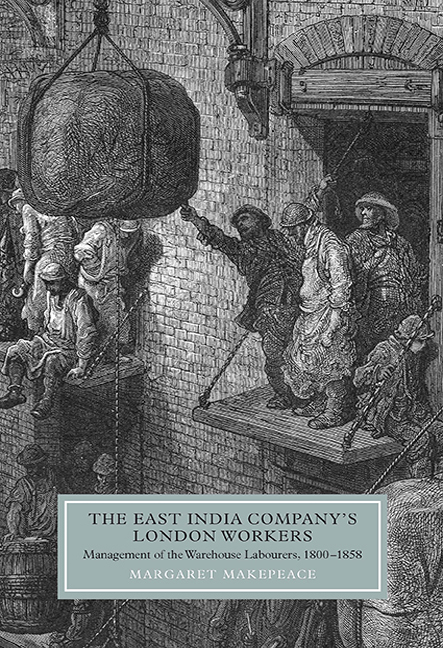Book contents
- Frontmatter
- Contents
- Figures and tables
- Dedication
- Acknowledgements
- Abbreviations
- 1 Introduction
- 2 The East India Company Warehouses
- 3 The Warehouse Labourers
- 4 Management Strategies: Incentives, Rewards and Benevolence
- 5 Management Strategies: Systems of Internal Control
- 6 The Royal East India Volunteers: The ‘Union of Civil and Military Dependence’
- 7 The Relationship Between the East India Company and its London Warehouse Labourers
- 8 The Warehouse Closures
- 9 Management of the Warehouse Labourers and Pensioners 1838–1858
- Conclusion: ‘Good Masters to the Lower Class of Their Dependents’
- Bibliography
- Index
2 - The East India Company Warehouses
Published online by Cambridge University Press: 13 April 2017
- Frontmatter
- Contents
- Figures and tables
- Dedication
- Acknowledgements
- Abbreviations
- 1 Introduction
- 2 The East India Company Warehouses
- 3 The Warehouse Labourers
- 4 Management Strategies: Incentives, Rewards and Benevolence
- 5 Management Strategies: Systems of Internal Control
- 6 The Royal East India Volunteers: The ‘Union of Civil and Military Dependence’
- 7 The Relationship Between the East India Company and its London Warehouse Labourers
- 8 The Warehouse Closures
- 9 Management of the Warehouse Labourers and Pensioners 1838–1858
- Conclusion: ‘Good Masters to the Lower Class of Their Dependents’
- Bibliography
- Index
Summary
the merchants of the East India Company began trading in 1600 from a room at the Nag's Head Inn in Bishopsgate Street, London. Two hundred years later, the Company's extensive commercial and imperial functions were managed from a large range of buildings in the City and the surrounding area: administrative and commercial offices, warehouses, almshouses with a chapel, a military recruitment centre, a mint and an inspection room for firearms. The peak period for property accumulation and development was the late eighteenth century, prompted in part by the need to store the greatly increased amount of tea shipped from China.
In 1800, Company operations were directed from East India House in Leadenhall Street which had been reconstructed on an extended site in the late 1790s to create an elegant building with a wide impressive frontage in keeping with the Company's importance and power. By this date, the Company had also acquired extensive warehousing near its headquarters to store not only goods shipped to London from India, China and Southeast Asia, but also woollen cloth and military stores for export to Asia, and passengers’ baggage. Extant evidence suggests that metals such as lead, iron, tin and copper exported to Asia by the Company were not stored in the main warehouses: there was a separate export warehouse situated at Botolph Wharf near Thames Street. Since East India ships were too large to come up the Thames as far as the legal quays supervised by the Custom House, their cargoes were taken off at Blackwall and transhipped by hoy. On arrival at the quays, the goods were removed from the hoys under the watchful eye of the revenue officials and taken by road to the Company's up-town bonded warehouses situated north of the Thames to be sorted, stored and sold.
Throughout the Company's earliest days, warehouse space was rented as and when it was needed. For instance, the directors hired the Royal Exchange vault in Cornhill when the Ascension returned from Sumatra in June 1603 laden with pepper, cloves, cinnamon and gumlac (a dark-red resin used as a dye). Storage room in the City continued to be leased even after the Company constructed a dockyard at Blackwall in 1614. No warehouses for imported goods were provided at Blackwall because the directors considered the isolated dockyard too insecure even though it was surrounded by a wall twelve feet in height.
- Type
- Chapter
- Information
- The East India Company's London WorkersManagement of the Warehouse Labourers, 1800–1858, pp. 17 - 39Publisher: Boydell & BrewerPrint publication year: 2010



